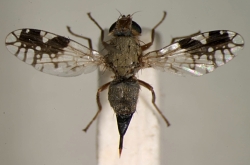Suborder Cyclorrhapha (Flies - Order: Diptera)
Back to the main Flies page.

Hoverflies, like this Helophilus pendulus, are often very striking insects.
These flies pupate in barrel shaped puparia and escape from them through circular openings. The larvae of many species are what we know as maggots - they are headless, and taper towards the front.
The sub-order Cyclorrhapha is further classified into the Aschiza and the Schizophora, depending on whether they have a little tool called a ptilinum to help them escape from their puparia. The Aschiza are the ones that don't have a ptilium.
The Schizophora (whose members do have a ptilium) is further divided into three more groups - the Acalyptratae and the Calyptratae, and the Pupipara. The Calyptratae have calypters, or little flaps, covering the base of the halteres, whilst the Acalyptratae don't have these.
Examples from the Aschiza group of the Cyclorrhapha are the scuttle flies (Phoridae) of which there are about 280 British species. The front edge of their wings is spiny and they are humpbacked. They scuttle across vegetation and sometimes swarm on window panes. One of these is knows as the Coffin Fly Conicera tibialis because it regularly breeds in human corpses after burial (see the Forensic entomology page on this Web site).
The Hoverflies or Syrphidae are among the most noticeable of all the Diptera as they are colourful and hover in the air in gardens. This is the largest family of true flies.
Hoverflies are abundant on flowers much of the year and feed on nectar and pollen. Many of them look like bees or wasps. For example the Drone Fly Eristalis tenax looks like a drone honey bee, which is a strategy to make them look dangerous when they're not at all. This is known as Batesian mimicry.
Hoverfly larvae are varied but include many aphid eating larvae, so they are useful insects to have in the garden! Other hoverfly larvae breed in water or on decaying matter, such as on compost heaps. Drone Fly larvae feed on rotting material in stagnant water, and are commonly known as rat-tailed maggots.
Among the group of the Schizophora known as Acalyptratae - very small insects with poorly defined thoracic features - are the picture winged flies or Tephritidae. One of these is the Mediterranean fruit fly Ceratitis capitata which is fond of a wide range of fruit in southern Europe. Another is the picture winged fly shown in the photo, is a species new to Britain discovered by AES member Peter Hodge during an AES field trip to Bognor Regis in August 2005.

Tephritis divisa, a picture winged fly new to Britain and discovered by AES member Peter Hodge during an AES field trip to Bognor Regis in August 2005.
Other suborders of flies:
Back to the main Flies page.
A to Z of insects
- Alderflies
- Ants
- Antlions
- Archaeognatha
- Barklice
- Bees
- Beetles
- Biting lice
- Booklice
- Butterflies
- Bugs
- Caddisflies
- Cockroaches
- Crickets
- Damselflies
- Dobsonflies
- Dragonflies
- Earwigs
- Fleas
- Flies
- Grasshoppers
- Lacewings
- Leaf insects
- Lice
- Mantids
- Mayflies
- Moths
- Praying Mantids
- Scorpionflies
- Snakeflies
- Stick insects
- Stoneflies
- Strepsipterans
- Sucking lice
- Termites
- Three-pronged bristletails
- Thrips
- True Bugs
- Wasps
- Web-spinners
- Zorapterans
- Non-insect hexapods
- Proturans
- Springtails
- Two-pronged bristletails
![Amateur Entomologists' Society home page [Logo]](/images/aes-logo-wplant.gif)